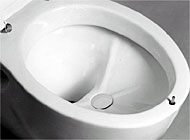Waste water management comes out the closet

In July, four families are set to move into new flats in a housing project in Zurich. They are taking part in a pilot project, which could revolutionise waste water management in Switzerland.
Traditionally, waste water management has been an end-of-pipe system where any problems are dealt with in treatment plants. Now researchers are trying to tackle the problem at source with a recycling strategy using special urine-separating toilets.
The project is promoted by the Swiss Federal Institute for Environmental Science and Technology (EAWAG).
“Waste water treatment in Switzerland is in a deadlock situation,” says Jane Muncke, assistant to the project manager. “The technology is very complicated. With any new pollutants which are identified, we need to have new solutions in the plants.
“Our idea is to directly separate liquid waste water at the source rather than dilute it with drinking water and then transport it for treatment.”
All manner of undesirable objects are flushed down toilets and are not always efficiently removed in waste water plants. Among the micro-pollutants excreted via urine are natural hormones, residues of pharmaceuticals and nutrients.
Scientists believe that some of these compounds have already affected wildlife after entering natural water systems. Small concentrations of hormones are believed to have caused male fish to display female characteristics. Nutrients which enhance the growth of algae also pose a potential problem.
The idea of the NoMix toilet was borne in Sweden and introduced in eco-villages two years ago. Urine is collected separately, stored in tanks for about six months, and then used as fertiliser without being purified. In Switzerland, the Research Institute of Organic Agriculture in Frick is conducting feasibility studies into this application.
Jane Muncke says the aim is to recycle waste water just as nowadays we recycle solid waste: “We recycle glass, paper, cardboard, tin and our idea is basically to do the same with liquid waste.
“We’re starting off with urine, firstly because it’s easy to collect the urine separately as we already have the NoMix toilets. Secondly, if we succeed with urine, we can apply the technology to other fluid wastes – washing machines, dishwashers, showers, bathing water.”
There is one potential stumbling block to the widespread acceptance of the NoMix toilet. When they use the new toilet, men will have to sit rather than stand.
“It will be very interesting to see if men are prepared to sit on the toilet for the benefit of the environment,” says Muncke. “Whether that’s sufficient incentive is something we want to find out.”
by Vincent Landon

In compliance with the JTI standards
More: SWI swissinfo.ch certified by the Journalism Trust Initiative
You can find an overview of ongoing debates with our journalists here. Please join us!
If you want to start a conversation about a topic raised in this article or want to report factual errors, email us at english@swissinfo.ch.